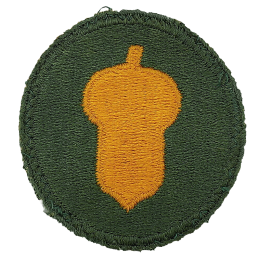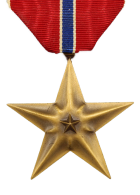In the snow of Germany
When we crouched down, we could immediately spot a pool of blood that was dammed-up by the casualty’s coat collar. Unlike veterans, replacement troops often wore the uniform that was issued to them, including bulky wool overcoats that they soon discarded. The medic leaned down and peeled back the young GI’s coat plus two wool shirts, administering a shot of morphine near the chest wound. The casualty was a rifleman from C Company, and he had apparently been in action only a few weeks. A quick referral to his dogtags revealed the name Gerald G. Juergens, and his blood type was O Positive, a rare strain.
Not far to our rear, artillery and mortar shells were crashing, including several rounds that sounded like duds. Lacking a foxhole, the two of us kept hitting the ground, then looking around to see if anyone, including the wounded man, was hit. Emerging in one piece, we knew we had to urgently move this young casualty to a hospital. If we could find a litter it would be an exhausting trudge down that hill in the Schnee Eifel (snow ridge) region of Germany.
The medic ran to his Battalion Aid Station, and in 20 minutes was back with another litter bearer, as well as an olive drab canvas litter. Now we were three, and we faced not only getting that casualty down that hill, but locating a jeep to transport him back to an Evacuation Hospital. After the medic packed morphine and an injection needle, we started slip-sliding down the hill, whose slope was thickly shrouded by trees, brush, plus a heavy overhanging mist. What remained to be determined was how far it was to the bottom and whether the three of us carriers had the strength to make it.
If we got to the bottom, we’d have to rush him to a hospital. As the medic stood by, the litter bearer and I started the carry, immediately learning that in late January in the Schnee Eifel, the snow underlayment melts and turns the mud to soft putty. Carrying this burden of almost 200 pounds, we faced a long slip-slide rather than a hike down that ridge. And though the three of us wore only light field jackets, our galoshes repeatedly jiggled over our GI shoes and made the footing even more uncertain. Within a few minutes we were forced to call timeout and doff those galoshes, to try new tactics to lean uphill and slide and bump sideways in our combat boots. But within half an hour of sliding both upright and half-seated, I caved in and, struggling, let go of the stretcher handles, forcing the other bearer to drop his end, tumbling the moaning casualty face-up in the snow. He lay there while the medic tried again to stem his blood flow with fresh bandages.
Picking up our burden once more, the brush began to thicken as we slid, so, for another two hundred yards we were forced repeatedly to duck under or circle around thick stands and around boulders. Then we did it again - one of us slid faster than the other and the litter flew out of our hands. This time our C Company casualty flipped and landed mostly on his stomach and face. By now the casualty’s moans were becoming more labored and more subdued. As we steadied the young GI’s head, the medic reached into his bag and withdrew another morphine shot the last in his bag. Then we resumed slipslidding, straining toward a covering of heavy brush that stretched up to meet us. Trying to circumvent that and to steady our load, we learned that we could, occasionally for short distances, lean into the thick brush for support.
But when the brush began to thin, the mud started to slump unevenly, causing one of us bearers to slide faster than the other. When that happened, there were more upsets, again flipping the young soldier on his face. By this time the grip in my hands was lost, the hands would no longer stay closed. Then I got an idea. I removed the young casualty’s overcoat, explaining to the other litter bearer and medic that I wanted to try something. My idea was to wear his heavy woolen overcoat and stick the litter handles into the outside pockets.
It worked for a few feet or yards until the pockets began gradually ripping, splitting stitch by stitch by stitch on both sides. By then the coat was useful mostly as tattered rags, so we threw the coat over the young casualty. There followed struggles and halts, and occasionally moans from the young GI before we finally slip-slid about fifty feet to the bottom. Reaching the road, we laid the wounded man at roadside, and, breathing hard, hands utterly powerless, sat in the snow waiting for an American vehicle to pass.
But the shelling on top of the hill was evidently choking off traffic below, and, after an hour, the medic informed us that the Co. C youth’s breathing was becoming even more faint. So picking him up again, we resumed trudging still having very little grip left except when we briefly folded our elbows as grips or tried to steady the litter on our shoulders, certain only that we didn’t know where we were going.
But in 15 minutes an American jeep, windshield and top down, came ripping through, providentially equipped with a litter mount. Waving the driver down, we found he had been ordered by an officer to head somewhere else. So again, hands virtually useless, we picked up the litter and resumed trudging. Ultimately, with starts and stops every few feet and past dusk, we staggered toward a tent hospital.
Somewhere before this point the medic had exhausted his morphine, and the young soldier’s moans had virtually stopped. A Captain, equipped with a stethoscope, was shouted for and walked out of a large pyramidal tent. We exchanged a few words, and he leaned over and examined the young C Company soldier, leaned back, then once more examined the soldier.
“Forget it,” the Captain finally said, putting away his stethoscope. “He’s gone.”
For taking part in this mission on Jan. 30, 1945, Cpl. Mitchell Kaidy, Co. D, 345th Infantry, 87th Division, was cited for the Bronze Star Medal.








